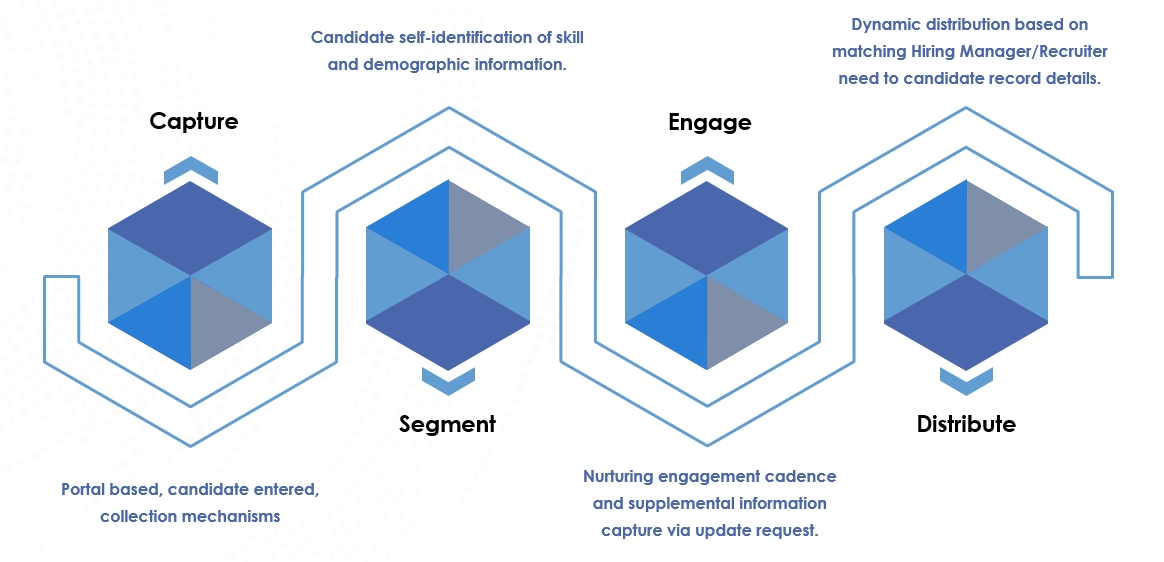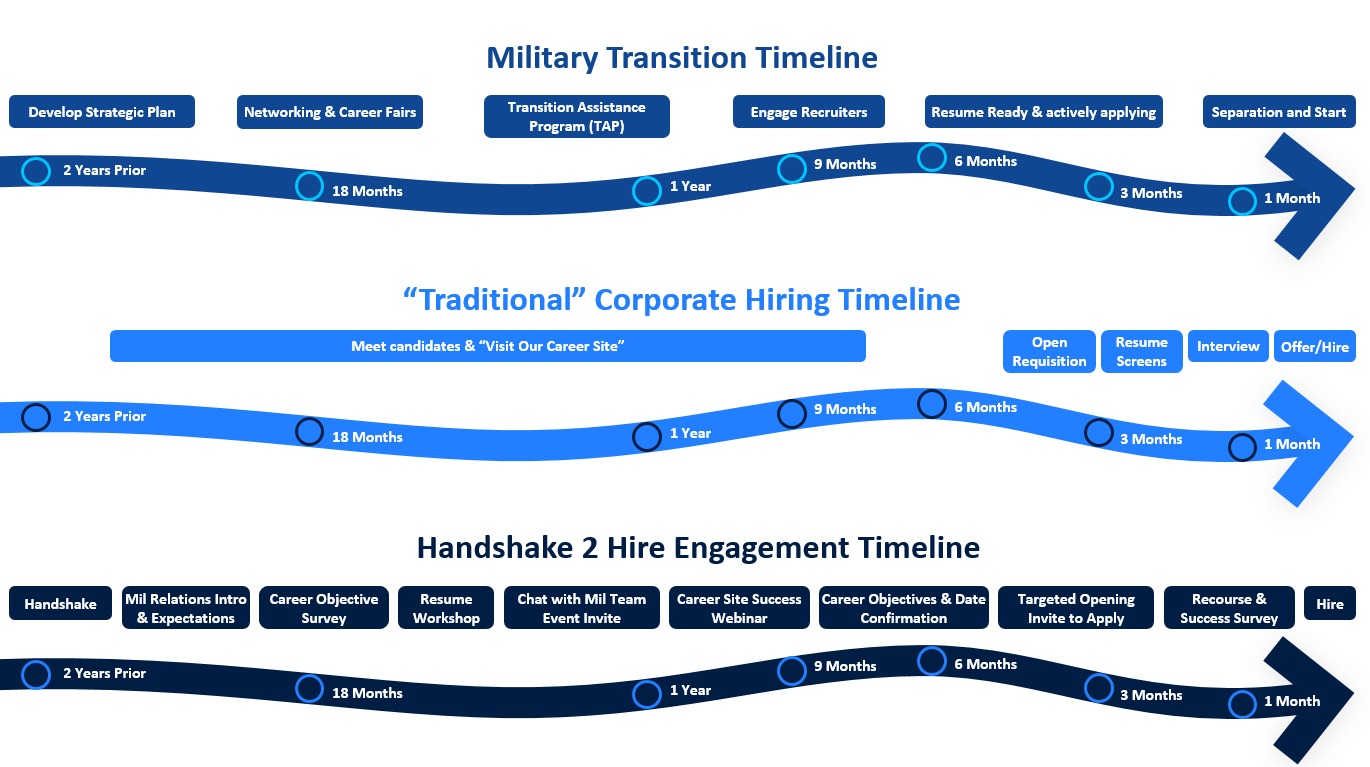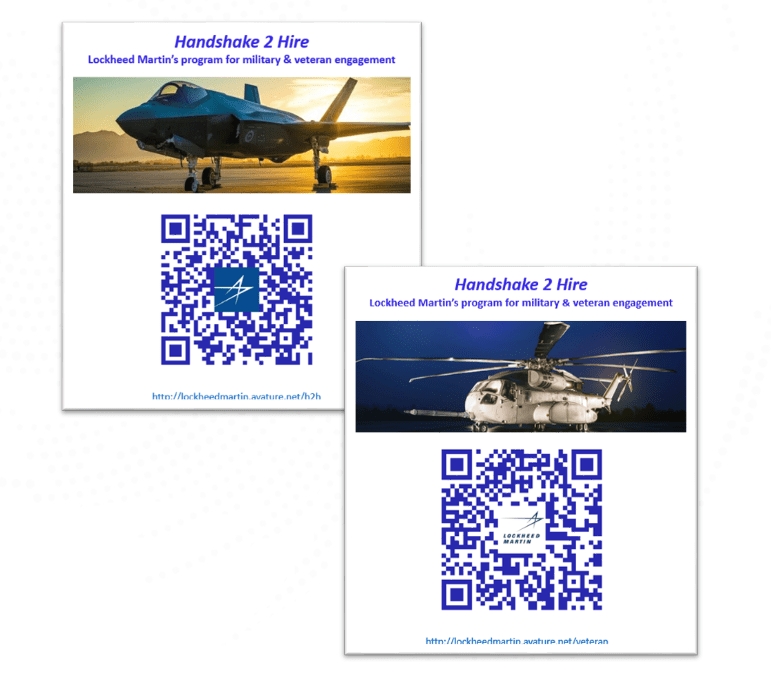Summary
Recruiting is tricky at the best of times but how would you go about hiring someone who may have never applied for a corporate role before? Lockheed Martin (LM) faces this challenge every day. As a leading global security and aerospace organization, around one in five of their 110,000 employees is ex-military. A target group that is accustomed to high levels of communication, responsiveness and organization, but understandably inexperienced when it comes to finding a civilian role.
When Lockheed Martin assessed their veteran recruitment strategy they noted a clear disparity between the two-year military transition preparation the candidates were receiving and the typical corporate recruitment timeline. This mismatch of timelines can create long radio silences ramping up insecurity and tension about what they are going to do once they leave the forces. In fact, despite being dropped into some of the most challenging combat deployment situations imaginable, the lack of engagement leaves many veterans saying it is one of the most stressful and anxious situations they have ever experienced. So as the organization that invented the SR71, the fastest aircraft ever built, designing an innovative process to attract and source service members in a new and unique way was not a challenge Lockheed Martin was going to shy away from.
The Challenges Facing Veteran Recruitment
Active service members usually know and start preparing for their exit from active service two years before their ETS (Exit Time of Service). From developing their strategic plan, networking, completing the TAP (Transition Assistance Program), to defining their start date, the transition is carefully planned by the military to ensure the process runs as smoothly as possible.
The only issue is that this timeline isn’t reciprocated in a standard corporate recruitment timeline. Any positions identified during the first 18 months were likely to be filled long before they’re actually ready to work, however leaving it until the last minute is very stressful for them. This left many enthusiastic job seekers in no man’s land or a ‘black hole’ where all the initial positive conversations, applications and engagement dry up until a new requisition becomes active.
Requisitions that were then opened at a maximum of six months before the start date could be offered as little as two weeks to a month before the ETS. After almost two years, their frustration reached a crescendo with stress and anxiety at their absolute highest as they had no job secured.
Knowing this, Lockheed Martin wanted to flip the script by not only creating a better candidate experience but giving back to a sector and supporting them in thanks for their service.
To start to build a new strategy, the Lockheed Martin team first looked at their tech stack to ascertain what needed to be addressed from the off. This uncovered challenges faced by key stakeholders involved:
Military Relations Manager’s Challenges:
- All candidate management was manual and subsequently time-consuming.
- Discharge dates vary from candidate to candidate which can be tough to keep on top of.
Candidate’s Challenges:
- As the length of recruitment timelines was different for nearly all candidates, misaligned timetables led to lengthy radio silences and missed opportunities for engagement.
- Many candidates had never been through a corporate application before so weren’t always sure what to do and when.
Hiring Manager’s Challenge:
- The vast array of different candidates was too broad for hiring managers to identify those candidates that were most likely to turn into a successful hire.
Talent Acquisition’s Challenge:
- Determining the relevance of candidates was also a manual process driven through excel spreadsheets and e-mail, making segmentation and matching an uphill battle.
With these identified, Lockheed Martin set about finding a way to improve the experience for each and every stakeholder and sculpt a new process that excelled in engaging veteran candidates.
Sculpting a Successful Hiring Strategy
Every day, military personnel are transitioning out of the forces, resulting in over 150,000 a year all with different ESTs. Lockheed Martin not only wanted to be able to stay on top of these processes and deliver a hyper-personalized experience but become a partner in their military transition (regardless of whether they are deemed to be a good fit for LM roles or not). For Jason Boone, Military & Veteran Outreach Leader at Lockheed Martin and his team of five, to say this was an ambitious goal is an understatement.
They knew that addressing their existing challenges and designing a new process would require a powerful platform to streamline their efforts, automate the collection and segmentation of candidates’ data and deliver the desired personalized experience to have the desired outcome of engaging and reassuring veterans. As such they chose Avature as their recruitment partner.
Handshake 2 Hire
From this, Handshake 2 Hire (H2H) was born, which is now an award-winning digital hiring pathway for military community members. The Handshake to Hire pathway is essentially built on four key objectives:
- Capture – Portal-driven, candidate-centered, data collection mechanisms.
- Segment (time, location, skills sets) – Self-identification of skills sets and demographic information allows for easier segmentation. Importantly this also lets them choose the date they would like to start, which sets the cadence of communication and is not necessarily the same as their EST.
- Engage – Nurturing engagement and providing supplemental information through personalized contact and communication
- Distribute – Dynamic distribution of candidates based on matching hiring manager needs to candidate records.

Lockheed Martin knew early on that if they are only reaching out to candidates when they have a need, the value of that contact would be much lower. Not only this but delivering useful material to candidates during the recruitment process enhances the candidate performance by teaching them how to tailor applications to match what the Lockheed Martin recruitment team is looking for.
“Seeing Handshake 2 Hire go from an idea on a napkin to (as of today) an award-winning program has been the highlight of my career. Thank you Rally® Recruitment Marketing for the recognition, and thank you Avature for being the engine to make this dream a reality!”
Jason Boone
Military & Veteran Outreach Leader at Lockheed Martin
The Process

The two-year Handshake 2 Hire timeline has more touchpoints, is more tailored, and with the addition of automation, easier to carry out than their previous methodology. Here is a sequential outline that highlights the key components of Handshake 2 Hire including the technology, audience, content, conversion methodology and candidate-centric focus:
- The candidate enters the H2H engagement program through an Avature-hosted signup portal and enters data that will be used for future personalization. This uses Avature’s universal tracking link feature which creates unique URLs for new signups depending on where the candidates are sourced and what data has been collected in order to enhance hiring activity tracking and segmentation.
Pre-COVID, the entry point was QR code scanning at career events and military transition offices. This allowed easy segmentation of high potential candidates and those who were less relevant. (An example of a group that isn’t so relevant is ‘M&Ms’: medical personnel from Montana. Lockheed Martin does not have any roles for medical professionals and they do not have an office in Montana. If both of these are labeled as preferences by the candidate, LM knows very early on that the likelihood they will be a successful candidate is slim). This, however, does not stop them from delivering valuable support and content to those to help make a transition, even if it is not with them.
Since the pandemic hit, the Avature platform has allowed the team to pivot from in-person to virtual events by sharing the URL link in online chats, webinars, social media and targeted email campaigns.
- Once the data is captured, content is delivered by time triggers relative to their preferred start date. Meaning the contact will be automatically spaced to keep a regular rhythm regardless of the distance between the date they first got in contact and their desired first day.
Below is the timeline of what they share and when:
-Two years prior: Handshake, whether in-person or virtual
-18 months prior: Social media links
-One year prior: Resume writing guide
-Nine months prior: Career site navigation video
-Six months prior: Invite to the Military Support Chat event
-One month prior: Survey of resources utilized and confirmation of career search status.
- The information around preferred start dates is then combined with skill data to help talent planning and demands. Skill segmentation and skill matching are both carried out through Avature for targeted candidate premarketing. Through the signup page, candidates select from a dataset of skills aligned to core business needs. These are based on the needs of hiring managers, which are also discovered through surveys built on the Avature platform. Once all this information is collated from both sides, candidates are matched with hiring managers based on skill segmentation to speed up proactive candidate distribution.
- All of this is carried out with a candidate-centric focus with their primary goal of supporting a successful career transition for America’s military members. Consciously moving away from traditional company-centric military recruiting programs that are overly focused on collecting as many candidates as possible. This is all facilitated by Avature’s platform that automates communication and supports the personalization of content and resources for the military members’ unique needs, skills and timeframes.
Results
The Handshake 2 Hire program has achieved results that speak for themselves:
Unique military candidate annual engagements went from 1,950 the year prior to 3,450 post H2H, amounting to a 77 percent increase. Hiring activity and accepted offers from military candidates went from 279 the year prior to 529 post H2H, resulting in a 90 percent increase. The interview and hiring efficiency, measured through the interview-to-hire ratio, made significant process relative to other ratios:
a. US national average: 4.8 to 1
b. LM enterprise average: 2.5 to 1
c. H2H candidate average: 1.96 to 1
Obviously, not all candidates go through a military relations team but the number of employees that were impacted by the team rose from 300 to 500 after the implementation of H2H.
Conclusion
Despite being a team of just five people, the impact Handshake to Hire has had on veteran recruitment has been dramatic. It is a process that has also been used to offer tailored support to college graduates as well as to increase diversity across the business by ensuring segmentation fits diversity objectives. It is a pathway that has now earned two Rally awards, Best Use of Recruitment Marketing Technology and Best Recruitment Marketing Campaign and as the pathway is built on Avature’s customizable platform, the ability of the campaign to scale up and go from strength to strength is ensured for the foreseeable future.
If you would like to learn more about the Handshake 2 Hire program, how it was implemented and more about its impact, listen back to the recent webinar featuring Jason Boone and Avature.


